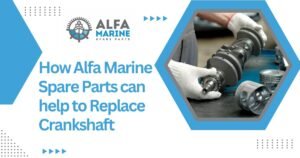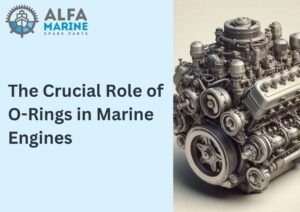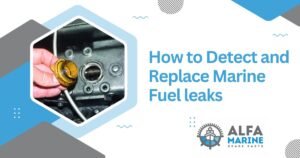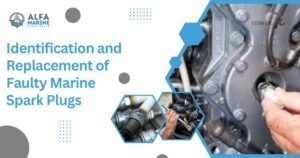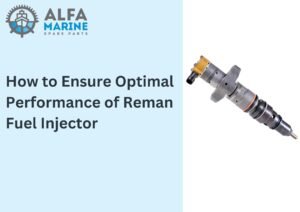For any boat owner, keeping your engine running smoothly and efficiently is paramount. Among the unsung heroes in this equation is the marine heat exchanger. This vital piece of equipment acts as a guardian against overheating, transferring heat away from your engine using coolant and seawater. Choosing the wrong heat exchanger can have disastrous consequences, leading to engine damage, reduced performance, and costly repairs.
This comprehensive guide, brought to you by the experts at Alfa Marine Spare Parts, will equip you with the knowledge and insights to select the perfect marine heat exchanger for boat.
Why Choosing the Right Heat Exchanger Matters?

A marine heat exchanger might seem like a simple piece of plumbing, but it plays a critical role in your engine’s well-being. Here’s why selecting the right one is crucial:
- Engine Overheating: An undersized or incompatible heat exchanger won’t be able to effectively remove heat from your engine. This can lead to overheating, a condition that can cause warped cylinder heads, blown gaskets, and even engine seizure. These repairs can be incredibly expensive and time-consuming, putting a damper on your boating adventures.
- Reduced Efficiency: An improperly functioning heat exchanger forces your engine to work harder to maintain optimal operating temperature. This translates to reduced fuel efficiency, higher operating costs, and potentially increased emissions.
- Long-Term Reliability: By ensuring your engine operates at the correct temperature, you’re extending its lifespan and reducing the risk of premature wear and tear.
Investing in the right heat exchanger is an investment in the health of your boat. It’s a proactive measure that saves you money and frustration in the long run, keeping you and your loved ones enjoying worry-free days on the water.
Understanding Marine Heat Exchangers
Before delving into the selection process, let’s explore the inner workings of a marine heat exchanger. Most commonly, these systems utilize a shell and tube design. Here’s a breakdown of the key components:
- Shell: This is the outer housing, typically constructed from a corrosion-resistant material like bronze or high-grade stainless steel. Seawater flows through the shell, surrounding the tubes.
- Tubes: A bundle of thin tubes carries the engine coolant. These tubes are typically made from copper or cupro-nickel, known for their excellent heat transfer properties.
- Tube Plates: These plates hold the tubes in place within the shell, creating a watertight seal. They are also made from a corrosion-resistant material.
Coolant (usually a 50/50 mixture of water and antifreeze) circulates through the tubes, absorbing heat from the engine block and cylinder head. Meanwhile, seawater flows through the shell in the opposite direction, carrying away the absorbed heat from the coolant.
Types of Marine Heat Exchangers

While the shell and tube design is the most prevalent, there are a couple of other, less common types of marine heat exchangers:
1. Plate Type Heat Exchanger
These compact heat exchangers utilize thin, corrugated metal plates that create a large surface area for heat transfer between the coolant and seawater. They offer several advantages, including a lightweight design and the ability to handle high-pressure fluids. However, they are generally less durable than shell and tube exchangers and are more susceptible to clogging with debris or marine growth, making them a less suitable choice for the harsh saltwater environment.
2. Plate Fin Heat Exchanger
Similar to plate type exchangers, these utilize thin plates with fins soldered or brazed onto them. The fins increase the surface area for heat transfer, making them more efficient than standard plate exchangers. However, the brazing process can be a weak point, and these exchangers are generally not recommended for marine applications due to potential corrosion concerns.
3. Dynamic Scraped Surface Heat Exchanger
These exchangers incorporate a rotating blade or wiper that continuously scrapes the heat transfer surfaces. This scraping action helps prevent the buildup of fouling and debris, making them a good option for applications with heavy contaminants. However, the moving parts introduce complexity and require additional maintenance, making them less common in marine settings.
4. Phase Change Heat Exchanger
These exchangers utilize a change of state (like a liquid turning into a gas) to absorb and release heat. While offering high efficiency, they are complex and often require additional equipment, making them impractical for most marine applications.
5. Spiral Heat Exchanger
These exchangers feature long, spirally wound channels for the coolant and seawater. They offer a compact design and good efficiency, but their complex geometry can make them difficult to clean and maintain. Additionally, they may not be as readily available as shell and tube exchangers for marine engines.
6. Direct Contact Heat Exchanger
In these exchangers, the coolant and seawater come into direct contact with each other. While offering high efficiency and a simple design, they are not suitable for marine applications because of the risk of saltwater contaminating the engine coolant.
Popular Marine Heat Exchanger Brands
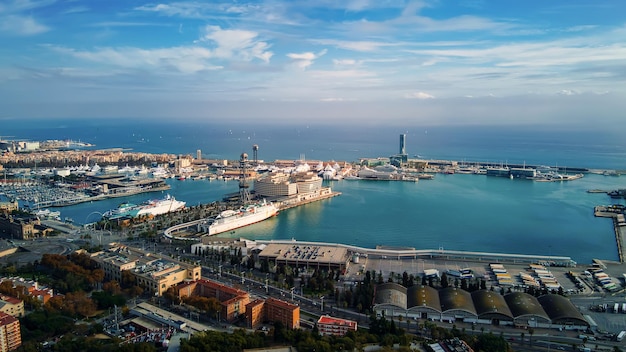
The marine industry boasts a wide range of reputable heat exchanger manufacturers. Here are some of the leading brands known for their quality and performance:
- Caterpillar
- Detroit Diesel
- Cummins
- John Deere
- Yanmar
- Perkins
- Volvo Penta
- Doosan
- Mitsubishi
- Wärtsilä
- Deutz
- Scania
- MAN
- MTU
- Bosch
Explore more top brands here!!!
Factors to Consider When Choosing a Marine Heat Exchanger

With a variety of options at your disposal, selecting the optimal heat exchanger requires careful consideration of several key factors:
1. Engine Compatibility
This is the most crucial factor. The heat exchanger must be specifically designed for your engine make and model. Using an incompatible model can lead to leaks, insufficient cooling, and even damage to your engine.
Consult your engine manual
It will typically list compatible heat exchanger options.
Contact your authorized engine supplier
We at Alfa Marine Spare Parts can provide expert advice and recommend suitable heat exchangers for your specific engine.
2. Quality and Durability: Built to Withstand the Harsh Marine Environment
A marine heat exchanger operates under demanding conditions. Saltwater is highly corrosive, and constant exposure can take a toll on lesser-quality materials. Here’s why prioritizing quality and durability is essential:
Material Selection
Look for heat exchangers constructed from high-grade materials like copper, cupro-nickel, and bronze for the tubes and shell. These materials offer superior resistance to corrosion and can withstand the harsh marine environment for extended periods.
Manufacturing Quality
The quality of welds, brazing, and overall construction is paramount. Look for brands known for their meticulous manufacturing processes, ensuring a leak-proof and long-lasting heat exchanger.
Brand Reputation
Research the reputation of different heat exchanger brands. Look for manufacturers with a proven track record of producing reliable and durable products for marine applications. Here at Alfa Marine Spare Parts, we only carry heat exchangers from brands we trust, ensuring you receive a product built to last.
Some Brands Renowned for Quality and Durability:
While all the brands listed previously offer good quality, a few stand out for their exceptional durability:
- Volvo Penta: Renowned for their commitment to quality and innovation, Volvo Penta heat exchangers are known for their robust construction and long lifespans.
- Doosan: Doosan heat exchangers utilize high-quality materials and meticulous manufacturing processes, resulting in a product built to endure the harshest conditions.
- Mitsubishi: Mitsubishi is a leader in heat transfer technology, and their marine heat exchangers are known for their exceptional durability and reliability.
- Wärtsilä: Wärtsilä heat exchangers are engineered for heavy-duty applications and are built to withstand the demanding needs of commercial vessels. While typically suited for larger engines, their commitment to quality is noteworthy.
- Deutz: Deutz heat exchangers are known for their robust construction and use of high-grade materials, ensuring longevity in saltwater environments.
3. Performance and Efficiency: Keeping Your Engine Cool While Saving Fuel
A marine heat exchanger’s primary function is to remove heat from your engine efficiently. Here’s why performance and efficiency matter:
- Heat Transfer Capacity: The heat exchanger’s ability to transfer heat from the coolant to the seawater is crucial. A well-designed heat exchanger will have a high heat transfer capacity, ensuring your engine stays cool even under demanding conditions.
- Flow Rate: The flow rate of both coolant and seawater plays a significant role in performance. An adequate flow rate is necessary to carry away heat effectively. Look for heat exchangers designed to optimize flow rates for your engine’s specific cooling requirements.
- Pressure Drop: As fluids flow through the heat exchanger, there is a natural pressure drop. Excessive pressure drop can hinder the flow rate and reduce cooling efficiency. Choose a heat exchanger that minimizes pressure drop while maintaining optimal flow.
- Fuel Efficiency: An efficient heat exchanger helps your engine maintain optimal operating temperature, reducing the strain and leading to better fuel economy.
Brands Known for Performance and Efficiency:
While many brands offer good performance, a few excel in efficiency:
- Scania: Scania heat exchangers are known for their innovative design and advanced features that optimize heat transfer and minimize pressure drop.
- MAN: MAN heat exchangers utilize high-performance materials and engineering to deliver exceptional cooling efficiency.
- MTU: MTU heat exchangers are designed for demanding applications and prioritize efficient heat removal while maintaining optimal engine performance.
4. Maintenance and Serviceability: Keeping Your Heat Exchanger Running Smoothly
Regular maintenance is essential for ensuring the longevity and performance of your marine heat exchanger. Here’s why considering maintenance and serviceability is crucial:
- Cleaning: Over time, salt deposits, debris, and marine growth can accumulate within the heat exchanger, reducing its efficiency. Look for heat exchangers with easy-to-clean designs that allow for regular maintenance. Some models may have removable end caps or cleaning ports for easier access.
- Parts Availability: Ensure replacement parts for your chosen heat exchanger are readily available. This is especially important for older models or less common brands. At Alfa Marine Spare Parts, we stock a wide range of heat exchangers and replacement parts from trusted brands, ensuring you have everything you need to keep your cooling system running smoothly.
- Serviceability: Consider the ease of servicing the heat exchanger, such as inspecting and replacing components like gaskets or seals. Look for designs that allow for easy access to critical components.
Bosch: While Bosch is primarily known for automotive applications, some of their heat exchanger models are designed for marine engines and are known for their user-friendly maintenance features.
Steps to Choosing the Right Marine Heat Exchanger for Boat

Now that you’ve gained a comprehensive understanding of marine heat exchangers and the key factors to consider, here’s a step-by-step guide to selecting the perfect one for boat:
1. Assess Your Boat’s Engine Specifications:
- Gather essential information about your engine, including:
- Make and Model: This is crucial for identifying compatible heat exchangers.
- Cooling System Capacity: This helps determine the appropriate size and heat transfer capacity of the heat exchanger. The cooling system capacity is typically listed in the engine manual or on a label on the engine itself.
- Year of Manufacture: Knowing the year can help narrow down compatible options, as some heat exchanger models might be specific to certain engine generations.
2. Identify Compatible Heat Exchanger Options:
- Consult your Engine Manual: The manual usually lists compatible heat exchanger models for your specific engine.
- Contact your Authorized Engine Supplier: Our expertise can be invaluable in recommending suitable heat exchangers based on your engine and boat’s specific needs. We also offer OEM heat exchangers, ensuring a perfect fit and performance.
- Research Reputable Aftermarket Brands: Aftermarket brands can offer a cost-effective alternative to OEM heat exchangers while maintaining good quality. Look for brands known for their compatibility with your engine make and model. Here at Alfa Marine Spare Parts, we can help you navigate the options and recommend reliable aftermarket heat exchangers.
3. Compare Performance and Efficiency Ratings:
Once you have a shortlist of compatible heat exchangers, compare their performance and efficiency ratings:
- Heat Transfer Capacity (BTU/hr): This indicates the amount of heat the exchanger can remove per hour. Choose a heat exchanger with a BTU rating that exceeds your engine’s cooling requirements, especially if you operate in hot climates or with heavy loads.
- Flow Rates (GPM): Ensure the coolant and seawater flow rates of the heat exchanger match the specifications of your engine’s cooling system. Insufficient flow rates can hinder cooling efficiency.
- Pressure Drop (psi): Look for a heat exchanger with minimal pressure drop to maintain optimal flow rates.
4. Research Maintenance and Service Requirements:
While most marine heat exchangers require regular cleaning, some models offer easier access and user-friendly features. Here’s what to consider:
- Cleaning Difficulty: Look for heat exchangers with removable end caps or cleaning ports for easier access to internal components.
- Parts Availability: Ensure replacement parts for your chosen heat exchanger are readily available. This is especially important for less common brands or older models. Alfa Marine Spare Parts offers a comprehensive selection of heat exchangers and parts from trusted brands to keep your cooling system running smoothly.
- Serviceability: Consider the ease of inspecting and replacing components like gaskets or seals. Look for designs that allow for easy access to critical components.
5. Consider Your Budget and Needs:
- OEM vs. Aftermarket: OEM heat exchangers are typically more expensive but ensure a perfect fit and performance. Aftermarket options offer a cost-effective alternative while maintaining good quality. Weigh the cost against the benefits and choose the option that best suits your budget and needs.
- New vs. Remanufactured: Remanufactured heat exchangers offer a more budget-friendly option compared to new ones. However, ensure the remanufacturer has a good reputation and uses high-quality parts.
Choosing the Right Heat Exchanger for Optimal Performance and Peace of Mind
By following these steps and considering the factors discussed, you can select the ideal marine heat exchanger for boat. Remember, investing in a high-quality heat exchanger is an investment in the health and longevity of your engine. A properly functioning heat exchanger ensures your engine operates at the optimal temperature, leading to:
- Improved Performance: A cool engine runs more efficiently and delivers optimal power.
- Reduced Fuel Consumption: An efficient heat exchanger helps your engine maintain the correct operating temperature, leading to better fuel economy.
- Extended Engine Life: Proper cooling prevents engine overheating, reducing wear and tear and extending the lifespan of your valuable investment.
- Peace of Mind: Knowing you have a reliable heat exchanger in place gives you peace of mind when venturing out on the water.
Contact Alfa Marine Spare Parts for Expert Assistance
If you have any questions about choosing the right marine heat exchanger for boat, don’t hesitate to contact Alfa Marine Spare Parts. Our team of experts has extensive knowledge of various heat exchanger brands and models. We can help you assess your engine’s needs, recommend compatible options, and guide you through the selection process. We also offer a wide range of heat exchangers


